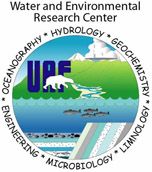

 |
 |
||
 |

Intersections of water, |
||
Industrial Water Use: 20th Century Historical industrial water use on the Seward Peninsula was dominated by placer gold mining. The amount of water used for mining purposes depended greatly on water availability, and was highly seasonal. All available surface water was often diverted into ditches for mining activities during the summer months. Industrial water demand decreased after the Nome gold rush because mining technology required less water and mining activity itself had decreased.
The Miocene Ditch flume cut into this cliff (Figure 1) still remains a visible part of the landscape. On the left is a picture taken in 1900, and on the right, 104 years later, a picture taken of the same ditch from the other side of the outcropping. The increased vegetation in the rock cut suggests that this flume permanently changed the hydrology of this area. The people standing above the ditch give an indication of the ditch size.
Photo Courtesy of University of Washington Libraries, Special Collections, Hegg 1642
Photo taken by Erin Strang
Figure 1. Miocene ditch flume, 1900 and 2004.
An estimate of the total amount of water used for mining was made by comparing the ditch flow in gauged ditches versus their known capacities. A 'percent-full factor' was then calculated by dividing gauged flow by capacity on a monthly basis. This factor was then used to infer the flow in ungauged ditches based on their known capacities. Summer flows in gauged ditches reached a maximum155 million gallons per day in 1909, corresponding to a maximum daily estimate of 634 million gallons per day in gauged and ungauged ditches. Ditch networks were actively maintained until the summer of 1911, when mining activities began to slow down. Many of these ditches are still visible cuts into hillsides (Figure 1).
This material is based upon work supported by the National Science Foundation under Grant No. OPP-0328686. Any opinions, findings, and conclusions or recommendations expressed in this material are those of the authors and do not necessarily reflect the views of the National Science Foundation. UAF is an affirmative action/equal opportunity employer and educational institution. The University of Alaska Fairbanks is accredited by the Northwest Commission on Colleges and Universities.
|
_